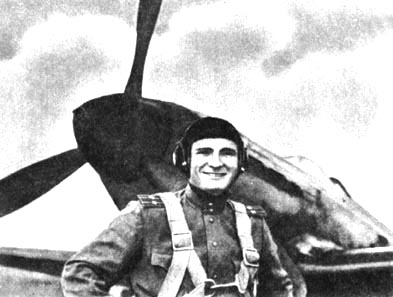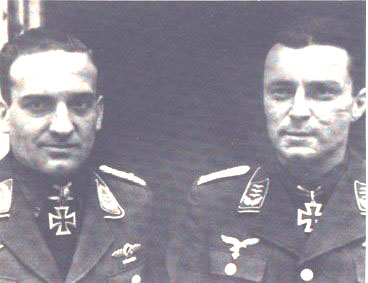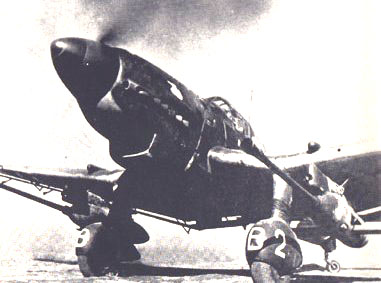
Lev Shestakov &
Hans-Ulrich Rudel

 |
 |
|||||||||||||
|
|
To
the left Hans-Ulrich Rudel. To the right his radio operator, Oberstabsarzt
Ernst Gadermann.
|
Having drawn his first blood as a fighter pilot in the Spanish Civil War, Lev Shestakov flew in defense of Odessa as commander of 69 IAP (Fighter Aviation Regiment) in the first months of the Russo-German war.
The losses dealt to the Romanian Air Force above Odessa in 1941 by Shestakov's fighter pilots compelled the Romanian High Command to withdraw its entire air force from the Eastern Front.
A few months later, no less than twelve pilots of 69 IAP were awarded as Heroes of the Soviet Union. 69 IAP was adopted a guard's unit as 9 GIAP. During the Battle of Stalingrad, 9 GIAP became the first real "ace unit" when some of the most successful Soviet fighter aces of that time were posted to 9 GIAP.
Lev Shestakov eventually carried out more than 200 missions during the war, took part in 32 aerial combats and was credited with 26 kills before being killed in action in March 1944.
According to Lavrinenkov's book, Lev Shestakov fought a private war with a well-known German Stuka ace - a Kurt Renner, who was awarded the "Golden Knight's Cross".
No such Stuka ace existed, but the famous Stuka flyer Hans-Ulrich Rudel - who served in the same operational area as did Shestakov - was the only person to be awarded the Knight's Cross with the Golden Oak Leaves.
Interestingly, Lavrinenkov, who joined Shestakov's 9 GIAP in the fall of 1942, describes how he once met Rennerí on the ground. On August 23, 1943, Lavrinenkov's Airacobra was hit by debris from a FW 189 that he had shot down. Lavrinenkov bailed out over enemy-held territory and was captured by the Germans. He was brought to the Stalino airfield, where he claims to have been introduced to "Renner". According to Lavrinenkov, "Renner" had thought that the Soviet POW was Shestakov, because he had flown the Airacobra with call-code 01, indicating that it was the unit commander's aircraft. Later, Lavrinenkov managed to escape from a POW transport due to Germany, joined a partisan detachment and eventually managed to make it back to the regular Soviet troops, where he re-joined 9 GIAP and took up combat flights again.
During this time, Hauptmann Hans-Ulrich Rudel (appointed commander of III./St.G. 2 Immelmann in September 1943) was stationed in Stalino.
During the first months of 1944, Lev Shestakov was hunting a Ju 87 "with a viper painted along its fuselage sides" - assuming that this conspicuos aircraft was flown by "Renner". Major Rudel certainly flew a Ju 87 G - one of the few Ju 87s still active in 1944 - over the same battlefields as Shestakov during this time. Due to his considerable successes against Soviet tanks, Rudel was a highly coveted prey among the Soviet fighter pilots - as confirmed in Rudel's autobiography. Until March 1944, Rudel was credited with the destruction of more than 200 Soviet tanks and was awarded with the Diamonds to his Knight's Cross with Oak Leaves and Swords.

In reality, Rudel survived the war. No other famous Stuka ace was killed on March 13, 1944, nor is it known that Rudel ever flew a Ju 87 with a viper painted on its fuselage side (although he used a Ju 87 with a chevron and two horizontal bars painted on the fuselage side, which was quite unsusual in the Stuka units).
It is quite possible that the Soviet account is an attempt to add glory to the event when one of the highest esteemed fighter pilots was killed in a fight with a single Ju 87.
In his autobiography, Hans-Ulrich Rudel recalls how his Ju 87 once came under attack from an excellent La-5 pilot:
"I just can't understand how he manages to follow my sharp turns in his fighter aircraft," wrote Rudel. Rudel started preparing himself for the final end, as he suddenly heard his rear-gunner, Stabsarzt Ernst Gadermann, cry over the R/T: "Got the Lag!" Rudel continues: "Was he shot down by Gadermann, or did he go down because of the backwash from my engine during these tight turns? It doesn't matter. My headphones suddenly exploded in confused screams from the Russian radio; the Russians have observed what happened and something special seems to have happened... From the Russian radio-messages, we discover that this was a very famous Soviet fighter pilot, more than once appointed as Hero of the Soviet Union."